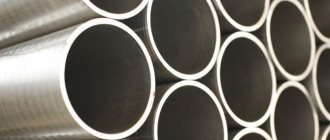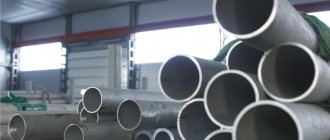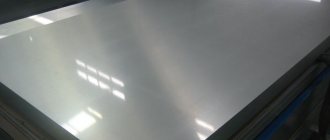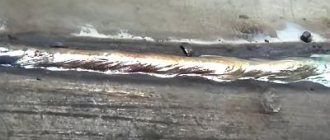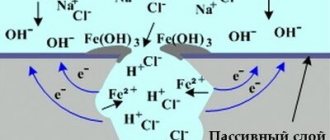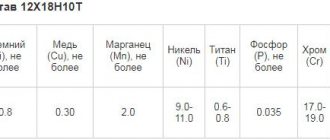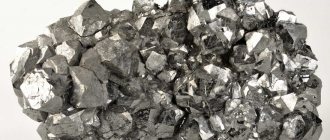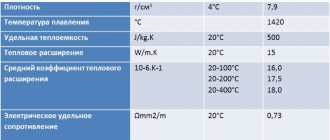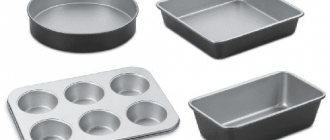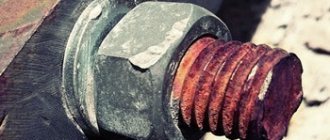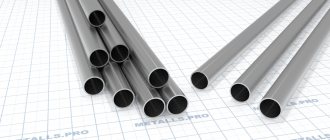Chemical composition
Decoding the steel grade St3 indicates the main components in its composition - iron (97%) and carbon (0.14-0.22%). The main quality of the alloy—its hardness—depends on the carbon concentration. The steel also contains small amounts of:
- manganese – 0.4-0.65%;
- silicon – 0.15-0.17%;
- nickel and chromium – 0.3% each;
- arsenic – 0.08%;
- copper – up to 0.3%;
- sulfur – 0.05%;
- phosphorus – 0.04%;
- nitrogen – up to 0.008%.
A feature of the St3 alloy is the strict regulation of the content of harmful impurities - sulfur and phosphorus. Phosphorus reduces the plasticity of the metal when exposed to high temperatures, and sulfur, when interacting with iron, forms sulfides, causing the phenomenon of red brittleness. It should be noted that there is an increased concentration of nitrogen, which accounts for almost 0.1%. In accordance with GOST 380-2005, the alloy is marked with accompanying indices that indicate the degree of deoxidation, for example, St3Gsp:
- the first two letters indicate carbon steel of ordinary quality;
- the number “3” means the serial number of the brand according to this GOST;
- the sign “G” indicates a modification with a high manganese content;
- “sp”, “kp”, “ps” – degrees of deoxidation.
Substitutes for steel grade St3 can be:
- C245, according to GOST 27772-88;
- C285;
- VSt3Sp.
Foreign analogues are labeled according to different rules:
- A57036, K01804 – USA;
- 40B, 722M24, HFS4 – UK;
- 1.0038, DC03 – Germany;
- E24-2, E24-4 – France;
- SS330, SS400 – Japan;
- Fe360B, Fe360C – Italy;
- G235C – China;
- RSt360B – Austria;
- Fe235D – Hungary.
The product range includes:
- long and shaped steel according to GOST 2591-2006;
- sheets of various thicknesses and stampings;
- pipes and fittings, according to GOST 10705-80;
- tapes and strips that are produced in accordance with GOST 14918-80;
- wire of different sections.
GOST
Welding stainless steel
The production of grade 20 products has its own standards:
- Shaped and section-type rolled products are made in accordance with the norms and rules of GOST, published in the following numbers: 1050-88, 2590-2006, 2591-2006, 2879-2006, 8509-93, 8510-86, 8240-97, 8239-89.
- The calibrated rod is manufactured in accordance with GOST standards: 7417-75, 8559-75, 8560-78, 10702-78.
- Silver and ground rods are regulated by GOST 14955-77.
- Thick sheets are blanks made in strict accordance with GOST 1577-93 and GOST 19903-74 standards.
- Thin sheets are manufactured in accordance with GOST 16523-97.
- The production of tapes occurs strictly in accordance with four GOST standards: 6009-74, 10234-77, 103-2006, 82-70.
- Wire products must be prepared in accordance with GOST 5663-79 and GOST 17305-91.
- Forged blanks, as well as forgings, are manufactured in accordance with the rules and accepted standards of GOST 8479-70.
- Pipes are subject to the regulations of seven GOSTs: 10704-91, 10705-80, 8731-74, 8732-78, 8733-74, 5654-76 and 550-75.
Stainless steel 12Х18Н10Т
Substitutes
Substitute - steels 08Х18Г8Н2Т, 10Х14Г14Н4Т, 12Х17Г9А4, 08Х22Н6Т, 08Х17Т, 15Х25Т, 12Х18Н9Т.
Foreign analogues
| Germany DIN | Brand | X10CrNiTi18-9 |
| Number | 1.4541 | |
| USA (AISI, SAE, ASTM) | 321 | |
| France (AFNOR) | Z10CN18 | |
| UK (BS) | 320S31 | |
| Sweden (SS) | 2337 | |
| Italy UNI | — | |
| Japan | SUS321 | |
IMPORTANT!!! The possibility of replacement is determined in each specific case after assessing and comparing the properties of steels
Interpretation of steel 12Х18Н10Т
The number 12 indicates the average carbon content in hundredths of a percent, i.e. for steel 12Х18Н10Т this value is 0.12%.
The letter “X” indicates the chromium content of the steel. The number 18 after the letter “X” indicates the approximate amount of chromium in steel as a percentage, rounded to the nearest whole number, i.e. chromium content about 18%.
The letter “N” indicates the nickel content of the steel. The number 10 after the letter “N” indicates the approximate amount of nickel in steel as a percentage, rounded to the nearest whole number, i.e. Nickel content is about 10%.
The letter "T" indicates the titanium content of the steel. The titanium content in steel does not exceed 1.5%.
Type of delivery
Long products, including shaped steel: GOST 5949-75, GOST 2590-88, GOST 2879-88. Calibrated rod GOST 7417-75, GOST 8559-75, GOST 8560-78. Polished rod and silver steel GOST 14955-77, GOST 18907-73. Thick sheet GOST 7350-77. Thin sheet GOST 5582-75. Tape GOST 4986-79. Wire GOST 18143-72. Forgings and forged blanks GOST 25054-81, GOST 1133-71. Pipes GOST 9940-72, GOST 9941-72, GOST 14162-79.
Weldability
Steel 12Х18Н10Т is weldable without restrictions. Welding methods: RDS, ESW and KTS (Contact Spot Welding). Subsequent heat treatment is recommended.
Technological properties
Forging temperature, °C: beginning 1200, end 850. Sections up to 350 mm are cooled in air. Cutting machinability - Kv tv.spl = 0.85 and Kv b.st = 0.35 in the hardened state at HB 169 and σw = 610 MPa. Flock sensitivity - not sensitive.
Chemical composition, % (GOST 5632-2014)
| Steel | C | Si | Mn | Cr | Ni | Ti | S | P |
| 12Х18Н10Т | no more than 0.12 | no more than 0.80 | no more than 2.00 | 17,0-19,0 | 9,0-11,0 | 5,0-8,0 | no more than 0.02 | no more than 0.40 |
Application of 12Х18Н10Т
Purpose - parts operating up to 600 °C; welded machines and vessels operating in dilute solutions of nitric, acetic, phosphoric acids, solutions of alkalis and salts and other parts operating under pressure at temperatures from -196 to +600 °C, and in the presence of aggressive media - up to +350 °C.
Corrosion-resistant (stainless) steel is of the austenitic class and is mainly used as corrosion-resistant, but can also be used as heat-resistant and heat-resistant. In terms of heat resistance, it is close to steel 12Х18Н9Т.
It is used for the manufacture of welded equipment in various industries.
Approximate application as heat-resistant steel
Purpose: pipes, furnace fittings, heat exchangers, muffles, retorts, exhaust pipes and manifolds, spark plug electrodes. Recommended maximum temperature for long-term use (up to 10,000 hours), 800°C.
The temperature at which intense scale formation begins in air is 850°C.
Unstable in sulfur-containing environments. They are used in cases where nickel-free steels cannot be used.
Approximate application as heat-resistant steel
Exhaust system parts, pipes, sheet and section parts.
Recommended maximum application temperature is 600°C.
Service life - Very long.
The temperature at which intense scale formation begins in air is 850°C.
Application of steel 12Х18Н10Т for bodies, covers, flanges, membranes and valve assembly made from rolled products, forgings (stampings) (GOST 33260-2015)
| steel grade | ND for supply | Temperature of the working medium (wall), °C | Additional instructions for use |
| 12Х18Н10Т GOST 5632 | Long products GOST 5949. Sheets GOST 7350. Forgings GOST 25054. Pipes GOST 9940, GOST 9941 (made of 12Х18Н10Т) | -270 to 350 | For welded fittings operating in aggressive environments: HNO3, alkalis, ammonium nitrate, food media, special equipment media, ship fittings, cryogenic media, hydrogen sulfide-containing media; for membranes |
| St. 350 to 610 | For welded reinforcement assemblies in the absence of a requirement for resistance to intergranular corrosion |
Application of steel 12Х18Н10Т for fittings fasteners (GOST 33260-2015)
| Steel grade, according to GOST 1759.0 | Material standard or specification | Application options | |||||
| Bolts, studs, screws | Nuts | Flat washers | |||||
| Ambient temperature, °C | Nominal pressure Pn, MPa (kgf/cm2) | Ambient temperature, °C | Nominal pressure Pn, MPa (kgf/cm2) | Ambient temperature, °C | Nominal pressure Pn, MPa (kgf/cm2) | ||
| 12Х18Н10Т | GOST 5632 | -196 to 600 | Not regulated | -196 to 600 | Not regulated | -196 to 600 | Not regulated |
The use of steel 12Х18Н10Т for the manufacture of spindles and rods (GOST 33260-2015)
| steel grade | ND for supply | Working environment temperature, °C | Additional instructions for use |
| 12Х18Н10Т GOST 5632 | Long products GOST 5949 | -270 to 350 | It is used for work in aggressive environments: nitric acid, alkalis, ammonium nitrate, food environments, environments of special equipment, shipbuilding, cryogenic equipment and hydrogen sulfide-containing environments. Used for welded joints |
| Long products GOST 5949 | St. 350 to 610 | Suitable for use in environments that do not cause intergranular corrosion |
Application of steel 12Х18Н10Т for bellows (GOST 33260-2015)
| steel grade | ND for supply | RD for the production of bellows | Working environment temperature, °C | Operating pressure Pp, MPa (kgf/cm2), no more | Additional instructions for use |
| 12Х18Н10Т GOST 5632 | Sheet GOST 5582. Tape GOST 4986, (for steel 1.4541) | GOST 21744, GOST 22388 | -260 to 550 | From 0.6 to 25.0 (from 6 to 250) | For water, steam, inert gases and cryogenic temperatures. For mildly aggressive environments - up to a temperature of 350°C. For corrosive environments - up to 150°C |
| Pipe GOST 10498 | -260 to 465 | From 0.15 to 3.10 (from 1.5 to 31.0) |
NOTE The table shows the limit values for temperatures and operating pressures. Specific combinations of application parameters (working pressure, axial stroke, temperature and full assigned life) are given in the regulatory documentation for bellows.
Application of steel 12Х18Н10Т for valve valve assembly
| steel grade | Working environment temperature, °C | Hardness | Additional instructions for use |
| 12Х18Н10Т GOST 5632 | -100 to 300 | 155…170 HB | The functionality of the valve assembly is ensured by the presence of surfacing or other wear-resistant coating in the mating part |
Application of steel 12Х18Н10Т for helical coil springs
| steel grade | ND for supply | Application temperature, °C | Additional instructions for use |
| 12Х18Н10Т GOST 5632 | Wire | -253 to 400 | Safety, control valves, low-magnetic springs |
Application of steel 12Х18Н10Т for gaskets
| steel grade | Type of semi-finished product | Application temperature, °C | Additional instructions for use | |
| Name | ND for supply | |||
| 12Х18Н10Т GOST 5632 | Thick heat-treated sheets | GOST 7350 | -253 to 600 | Suitable for use in corrosive environments |
Resistance of steel 12Х18Н10Т to sulfide corrosion cracking
| Method of forming blanks | Name of parts |
| Forgings, stampings, rolled products | Body, bonnet, stem, spindle, valve seal parts, bellows end parts |
Maximum permissible temperature for the use of steel 12Х18Н10Т in environments containing ammonia
| steel grade | Temperature of application of steels, °C at partial pressure of ammonia, MPa (kgf/cm) | ||
| St. 1(10) to 2(20) | St. 2(20) to 5(50) | St. 5(50) to 8(80) | |
| 12Х18Н10Т | 540 | 540 | 540 |
Maximum permissible temperature for the use of steel 12Х18Н10Т in hydrogen-containing environments
| steel grade | Temperature, °C, at partial pressure of hydrogen, PH2, MPa (kgf/cm2) | ||||||
| 1,5(15) | 2,5(25) | 5(50) | 10(100) | 20(200) | 30(300) | 40(400) | |
| 12Х18Н10Т | 510 | 510 | 510 | 510 | 510 | 510 | 510 |
NOTE
- The parameters for using steels indicated in the table also apply to welded joints.
- The partial pressure of hydrogen is calculated by the formula: PH2 = (C*Pp)/100, where C is the percentage in the system; PH2—hydrogen partial pressure; Pp is the operating pressure in the system.
Relative erosion resistance coefficient of reinforcement parts made of steel 12Х18Н10Т
| Details of the flow part of the fittings | Part material | Erosion resistance coefficient relative to steel 12X18H10T | Maximum pressure drop at which there is no erosive wear, MPa |
| Body, pipes, rod, plunger (gate), seat | 12Х18Н10Т | 1,0 | 4,0 |
NOTE
- The coefficient of erosion resistance of a material is the ratio of the rate of erosive wear of the material to the rate of erosive wear of steel 12Х18Н10Т (taken as 1).
- Materials are erosion-resistant if the coefficient of relative erosion resistance Kn is at least 0.5 and the hardness of the material is HRC≥28.
Resistance of steel 12Х18Н10Т against crevice erosion
| Durability group | Point | Erosion resistance against steel 12X18H10T |
| Persistent | 2 | 0,75-1,5 |
Resistance of steel 12Х18Н10Т against impact erosion
| Toughness Point | NV no more | Materials |
| 5 | 150 | Austenitic chromium-nickel stainless steel grade 12Х18Н10Т |
Application of steel 12Х18Н10Т for the manufacture of main parts of nuclear power plant fittings
| steel grade | Type of semi-finished product or product | Maximum permissible temperature of use, °C |
| 12Х18Н10Т GOST 5632, GOST 24030 | Sheets, pipes, forgings, long products. Fasteners | 600 |
Characteristics
Density ρ at test temperature, 20 °C - 7900 kg/cm3
Thermal conductivity coefficient λ W/(m*K) at test temperature, °C
| Steel | 20 | 100 | 200 | 300 | 400 | 500 | 600 | 700 | 800 | 900 |
| 12Х18Н10Т | 15 | 16 | 18 | 19 | 21 | 23 | 25 | 27 | 26 | — |
Electrical resistivity ρ, nOhm*m, at test temperature °C —
| Steel | 20 | 100 | 200 | 300 | 400 | 500 | 600 | 700 | 800 | 900 |
| 12Х18Н10Т | 725 | 792 | 861 | 920 | 976 | 1028 | 1075 | 1115 | — | — |
Specific heat capacity c, J/(kg*K), at test temperature, °C
| 20-100 | 20-200 | 20-300 | 20-400 | 20-500 | 20-600 | 20-700 | 20-800 | 20-900 | 20-1000 |
| 462 | 496 | 517 | 538 | 550 | 563 | 575 | 596 | — | — |
Thermal conductivity coefficient λ, W/(m*K), at test temperature, °C
| 20 | 100 | 200 | 300 | 400 | 500 | 600 | 700 | 800 | 900 |
| 15 | 16 | 18 | 19 | 21 | 23 | 25 | 27 | 26 | — |
Linear expansion coefficient α*106, K-1, at test temperature, °C
| 20-100 | 20-200 | 20-300 | 20-400 | 20-500 | 20-600 | 20-700 | 20-800 | 20-900 | 20-1000 |
| 16,6 | 17,0 | 17,2 | 17,5 | 17,9 | 18,2 | 18,6 | 18,9 | 19,3 |
Modulus of normal elasticity E, GPa, at test temperature °C
| Steel | 20 | 100 | 200 | 300 | 400 | 500 | 600 | 700 | 800 | 900 |
| 12Х18Н10Т | 198 | 194 | 189 | 181 | 174 | 166 | 157 | 147 | — | — |
Modulus of elasticity in torsional shear G, GPa, at test temperature °C
| Steel | 20 | 100 | 200 | 300 | 400 | 500 | 600 | 700 | 800 | 900 |
| 12Х18Н10Т | 77 | 74 | 71 | 67 | 63 | 59 | 57 | 54 | 49 | — |
Mechanical properties
| GOST | Delivery status | Section, mm | σ0.2, MPa | σb, MPa | δ5, % | ψ% |
| no less | ||||||
| GOST 5949-75 | Bar. Quenching from 1020-1100 °C in air, oil or water | 60 | 196 | 510 | 40 | 55 |
| GOST 18907-73 | Ground rod, processed to a specified strength | — | — | 590-830 | 20 | — |
| Cold-worked rod | Up to 5 | — | 930 | — | — | |
| GOST 7350-77 (transverse samples) | Hot-rolled and cold-rolled sheets: | |||||
| hardening from 1000-1080 °C in water or air | St.4 | 236 | 530 | 38 | — | |
| GOST 5582-75 (transverse samples) | hardening from 1050-1080 °C in water or air | Up to 3.9 | 205 | 530 | 40 | — |
| hard-worked | Up to 3.9 | — | 880-1080 | 10 | — | |
| GOST 25054-81 | Forging. Quenching from 1050–1100 °C in water or air | Up to 1000 | 196 | 510 | 35 | 40 |
| GOST 18143-72 | Heat treated wire | 1,0-6,0 | — | 540-880 | 20 | — |
| GOST 9940-81 | Seamless hot-deformed pipe without heat treatment | 3,5-32 | — | 529 | 40 | — |
Mechanical properties at elevated temperatures
| tsp, °С | σ0.2, MPa | σa, MPa | δ5, % | ψ% | KCU, J/cm2 |
| 20 | 225-315 | 550-650 | 46-74 | 66-80 | 215-372 |
| 500 | 135-205 | 390-440 | 30-42 | 60-70 | 196-353 |
| 550 | 135-205 | 380-450 | 31-41 | 61-68 | 215-353 |
| 600 | 120-205 | 340-410 | 28-38 | 51-74 | 196-358 |
| 650 | 120-195 | 270-390 | 27-37 | 52-73 | 245-353 |
| 700 | 120-195 | 265-360 | 20-38 | 40-70 | 255-353 |
Note.
Hardening from 1050-1100 °C in air.
Mechanical properties during long-term strength testing (GOST 5949-75)
| tsp, °С | Creep limit, MPa, not less | Creep rate, %/h |
| 600 | 74 | 1/100000 |
| 650 | 29-39 |
| tsp, °С | Long-term strength limit, MPa, not less | τ, h |
| 600 | 147 | 10000 |
| 650 | 78-98 |
Impact strength KCU
| Delivery status | KCU, J/cm2, at temperature, °C | ||
| +20 | -40 | -75 | |
| Strip 8×40 mm | 286 | 303 | 319 |
Note.
Fatigue limit σ-1 = 279 MPa at n = 107.
Sensitivity to aging embrittlement
| Time, h | Temperature, °C | KCU, J/cm2 |
| Ref. comp. | Ref. comp. | 274 |
| 5000 | 600 | 186-206 |
| 5000 | 650 | 176-196 |
Heat resistance
| Wednesday | Temperature, °C | Strength group or score |
| Air | 650 | 2-3 |
| 750 | 4-5 |
Find out more
Structural alloy steel 38ХА…
Steel 15HSND low-alloy structural...
Steel St0 - carbon steel of ordinary quality...
Steel 20Х23Н18 heat-resistant, heat-resistant, stainless…
Density of stainless steel
Solder for Stainless Steel
The density of a substance is calculated by dividing the mass of an object by its volume. Such calculations have already been made for all substances known to man, and metrological services periodically repeat and refine these measurements. In practice, people face another practical task: knowing the material from which the product is made, determine its mass.
The density of a substance is also called specific gravity (or, in everyday life, specific gravity) - that is, the mass of a solid physical body made of a given substance and having a unit volume.
Stainless steel
It should be noted that when using the term “mass”, in 99% of cases people are dealing with weight - the force of attraction of the physical body to the Earth. The fact is that to determine body weight in a strict physical sense, sophisticated equipment is required, available only in the largest scientific centers. For practical use, in most cases, conventional, more or less accurate scales using the Earth's gravity and springs, or levers and standard weights, or piezoelements are sufficient.
In practice, to calculate the weight of a linear or square meter of rolled metal, the specific gravity, or density of the material from which it is made, is used. In reference books on the assortment of rolled metal, among the main characteristics of each grade, the mass of a linear or square meter and the density value used in the calculations must be indicated.
However, you need to understand that the data in the directory is calculated based on the standard density of steel, most often it is 7.85 t/m3. At the same time, the actual density of a particular steel grade depends on the composition and specific amount of additives and can range from 7.6 to 8.8 t/m3.
This can give an error of up to 10% up or down for a product made from a very light or, conversely, very heavy alloy. For a small amount of metal the difference will be small and can be neglected. However, for complex products that use large volumes of metal, more accurate calculations will be required.
https://youtube.com/watch?v=eN9Y_AqExdI
The mass will be needed when creating an application for the purchase of metal. Based on the density of a given alloy, an adjustment is made to the reference values of the mass of one linear or square meter, and then the already specified value is used in the calculations.
Stainless steel welding coefficient
I ask you to consider the issue and provide clarification on the use of the coefficient -1.15 in accordance with clause 4.3.2 of MDS 81-37.2004 and clause 4.9 of MDS 81-35.2004 “For equipment made of stainless steel, when welding takes place during its installation” to prices FERm 13-02-004-1÷7 “Tanks made of corrosion-resistant and carbon steel, supplied assembled.”
The design institute considers the application of K = 1.15 (clause 4.3.2 MDS 81-37.2004, clause 4.9 MDS 81-35.2004) to the prices of FERm13-02-004-1÷7 “Tanks made of corrosion-resistant and carbon steel, supplied assembled form" is unfounded, because These positions are complex and averaged over the material of the tanks. In addition, local estimates for the installation of tanks made of corrosion-resistant steel additionally take into account the welding materials necessary for the installation of equipment, according to the design data.
For our part, we justify the legality of using this coefficient in paragraph. 1 clause 4.3.2. MDS 81-37.2004, resource part of prices FERm 13-02-004-1÷7, table 1 and 3 sections. No. 2 PNAE G-7-009-89.
Despite the fact that the title of the table in the collection FERM 13-02-04 “Tanks made of corrosion-resistant and carbon steel, supplied assembled,” the prices do not indicate a distinction between the materials from which the mounted tanks are made. Also, in the Technical Part to Section 2 of the FERM Collection No. 13, the average price for the materials from which the mounted structures are made is not indicated. According to para. 1 clause 4.3.2. MDS 81-37.2004 “In cases where the technical characteristics of the equipment do not indicate the material from which it is made, it is accepted in the FERM Collections that the equipment is made of carbon steel or gray cast iron.”
Validity of reference to paragraph. 1 clause 4.3.2. MDS 81-37.2004 is confirmed by the resource composition of the prices FERm 13-02-004-1 clause 4.97, where the main installation operation by which the structure (tank) is fixed in the design position is welding, the main welding materials in the prices FERm 13- 02-004-1÷7 - electrodes UONI13/45.
Welding materials for prices FERm 13-02-004-1÷7
| Price | Electrodes | Welding wire |
| Name | Name | |
| FERm 13-02-004-1 | SSSI 13/45 | — |
| FERm 13-02-004-2 | SSSI 13/45 | — |
| FERm 13-02-004-3 | SSSI 13/45 | — |
| FERm 13-02-004-4 | SSSI 13/45 | — |
| FERM 13-02-004-5 | SSSI 13/45 | — |
| FERM 13-02-004-6 | SSSI 13/45 | — |
| FERm 13-02-004-7 | SSSI 13/45 | — |
According to PNAE G-7-009-89 “Equipment and pipelines of nuclear power plants. Welding and surfacing" (section 2 "Welding materials", table 1) welding materials included in the prices of FERm 13-02-004-1÷7 are used for welding pearlitic class materials and are not used for welding austenitic class steels (table 3 PNAE G-7-009-89).
Based on the above facts, we believe that the prices of FERm 13-02-004-1÷7 of the table “Tanks made of corrosion-resistant and carbon steel, supplied assembled” reflect the technology for installing tanks made of carbon steel. In the case when, according to the project, it is necessary to install stainless steel structures, a coefficient of 1.15 must be applied to the prices of FERm 13-02-004-1÷7 in accordance with paragraphs. 4.3.2 MDS 81-37.2004 and 4.9 MDS 81-35.2004.
Answer
The standards of table GESNm 13-02-004 “Tanks” of the Collection for installation of equipment No. 13 “Equipment of Nuclear Power Plants” are developed for equipment made of carbon and corrosion-resistant steel, taking into account the average standard technology for installation on tanks of a certain capacity in m3 (0.1; 0. 5; 10; 16 and 40), per meter 1 t.
The standards for the installation of tanks, developed according to the average installation technology, are combined into one standard and price, based on the fact that the costs when converted to 1 ton of installation of tanks made of corrosion-resistant and carbon steel had similar indicators.
It is noted that the indicators of the combined standards in the Collection are given taking into account the technology for installing tanks made of carbon steel, as evidenced by the presence of UONI 13/45 pearlite class electrodes. It was assumed that when using standards, the costs of installing tanks are compensated by weight, given that the weight of tanks made of corrosion-resistant steel is higher than tanks made of carbon steel.
The practice of combining prices with similar indicators into one price was adopted when developing the 1991 estimate and regulatory framework in SNiP 4.06-91. The established procedure for combining standards was transferred to the 2001 estimate and regulatory framework.
However, combining tanks made of corrosion-resistant and carbon steel into one standard and price is not entirely correct and, in our opinion, requires adjustment. This conclusion was made after analyzing the data given in the new construction reference book “Gas-Electric Welder”, Rostov-on-Don 2007, (Construction and Design) when comparing welding speed indicators from the following tables:
“Approximate welding modes for butt joints of sheets made of carbon and low-alloy steel (Table 9) and stainless steel (Table 12). The data is given when working on direct and alternating current, with different thicknesses of welded sheets:
- depending on the type of current with a thickness of 1 mm, the welding speed indicators differ by 1.95 times; with a thickness of 1.2÷2 mm - 2.72 times;
- with alternating current and a thickness of 1.5 mm - 2.3 times.”
A comparison showed that the average welding speed of carbon steel sheets compared to stainless steel (corrosion-resistant) is higher, and therefore, when welding stainless steel sheets, the number of machine-hours of the welding machine and the labor costs of the worker servicing the welding machine should be changed towards increase.
Taking into account the rate of change in welding speed on stainless steel - 2.3 with alternating current:
- in GESNm 13-02-04-5, with the number of machine-hours for welding on the installation of carbon steel tanks - 4.7 machine-hours, and the total number of labor costs - 59 man-hours, increasing the work time for welding stainless steel sheets is 4.7 x 2.3 - 4.7 = 6.11 hours, which is an increase in total labor costs by 10.4% (6.11/59);
- according to GESNm 13-02-04-6, the number of machine hours for welding when installing carbon steel tanks is 4.69, machine hours, the total number of labor costs is 45 man hours. The increase in work time for welding stainless steel sheets is 4.69 x 2.3 - 4.69 = 6.1 hours, which is an increase in total labor costs by 13.5% (6.1/45);
- according to GESNm 13-02-04-7, the number of machine hours for welding sheets when installing carbon steel tanks is 4.13 machine hours, the total number of labor costs is 26 person hours. The increase in work time for welding stainless steel sheets is 4.13 x 2.3 - 4.13 = 5.37 hours, which is an increase in total labor costs of 20.7% (5.37:26).
An analysis of the costs of installing tanks made of corrosion-resistant and carbon steel shows that the standards for tanks of only small capacity were subject to combining into one position. The established procedure should not be extended to tanks with a capacity of 10 m3, 16 m3 and 40 m3, in which welding work has a significant volume compared to tanks of small capacity.
To resolve the issue of correct accounting of costs for installation of tanks made of corrosion-resistant steel, in agreement with the Customer, we recommend using GESNm 13-02-004-5.6.7 standards using a coefficient of 1.15 for stainless steel to labor costs and payment labor of workers - installers, provided for as part of unit prices, in accordance with clause 4.3.2 of MDS 81-37.2004 “Guidelines for the application of federal unit prices for installation of equipment.”
As for UONI 13/45 pearlite class electrodes, when installing tanks made of corrosion-resistant steel, they are subject to replacement and the necessary compensation if the costs of the required electrodes do not cover the limit of funds provided for by the regulations.
Food grade stainless steel
Stainless steel markings
Stainless steels are currently considered an almost indispensable material for creating food processing equipment. The grades of stainless steel approved for contact with food products were determined mainly based on the experience of wine production, which is carried out using the most corrosive processes and technologies. As a result, it turned out that when choosing a brand of food-grade stainless steel, one should take into account the duration of its contact with the food product. The longer the contact, the higher the corrosion resistance required.
Currently, stainless steel grades AISI 304, AISI 304L, AISI 430, AISI316, AISI 316L, AISI 316Ti, AISI 321 are widely used for the food industry. All of them are alloyed stainless steels. If you need food grade stainless steel, the brand can be any from this list, but you should know that AISI 304, AISI 430, AISI 316 do not contain stabilizing titanium. This reduces their corrosion resistance and makes them sensitive to mechanical, thermal and chemical influences. They can be used for short contact with food products under gentle operating conditions.
Features of stainless steel for the food industry
Food manufacturers most actively use stainless steel pipes. They must meet the requirements of the DIN 11850 standard, which determines the composition of the steel and the quality of the weld. Stainless steel pipes fully meet the increased requirements for hygiene and environmental friendliness of materials used in the production of equipment for the food industry and public catering. They are made from AISI 304 and AISI 316L steels, which exhibit the following properties:
- high corrosion resistance along the entire length of the pipe and in areas of welded joints;
- resistance to chemically aggressive environments;
- wear resistance;
- environmental safety and non-toxicity;
- compliance with migration (dissolution) standards of heavy metals in the working environment;
- maintaining smoothness parameters throughout the entire service life, which facilitates cleaning and maintenance of the equipment.
In food production, hot solutions of sulfamic acid or caustic soda are often used to clean equipment. In these conditions, it is better to choose AISI 316 stainless steel, which is more resistant to aggressive environments. For domestic conditions and public catering, where the metal does not interact with such solutions, you can use AISI 304 and cheaper AISI 430, AISI 410.
Below, for clarity, the types of stainless steels according to AISI used in food production, their compliance with other standards, including Russian, as well as the permissible applicability of stainless steel in various environments are presented.
Table 1. 1.
Translations of international standards for the designation of basic steels used in food production.
Table 1. 2.
(continued) Translations of international standards for the designation of basic steels used in food production
Table 2.
Applicability of stainless steels according to AISI. Corrosion resistance of steels according to AISI in various applications
Price
If you need food-grade stainless steel, the price for it will be determined by the presence of expensive alloying components in the composition
The quality of surface treatment of the selected products is also important. Equipment for the food industry places higher demands on stainless steel, which is used in more aggressive conditions, and in case of corrosion can harm huge volumes of products
Cheap food grade stainless steel can be used in everyday life and public catering.
How to identify food grade stainless steel?
To determine the composition of food-grade stainless steel and its suitability for corrosion resistance parameters, you can use a guide to stainless steel grades. If you have a sample of stainless steel of an unknown brand, its suitability can be checked by placing it in a two percent vinegar solution or in a working environment for two to three days. Steel can be used if the sample does not darken.
The common belief that food grade stainless steel can be determined using a magnet is erroneous. Among the grades of food grade stainless steel, there are both magnetizable and non-magnetizable steels. To make your choice, do not hesitate to consult with a specialist from the company where you are going to purchase stainless steel. The better you understand the food production processes for which you need stainless steel, the better your chances of making the right choice.
Stainless steel 12x18n10t characteristics
This stainless steel 12x18n10t has characteristics typical for its class. They are due to the presence of alloying additives - nickel, chromium, titanium carbides, etc. Thanks to nickel, the material goes into the austenitic class. Chromium is necessary for passivation and also provides reliable protection against corrosive destruction. The following material properties should also be noted:
- Excellent weldability;
- Resistance to alkaline, acid and saline solutions, and other aggressive environments;
- Mechanical strength ensured by the presence of silicon (up to 0.8%);
- Protection against intercrystalline destruction of the material. This feature is created by titanium,
A number of standards apply to this material. In particular, 5632-72 is a state standard for stainless steel 12x18n10t and other alloys that describe thermal conductivity, resistance to corrosion, thermal and chemical influences. The production of thin and thick types of rolled sheets of this grade is regulated by GOSTs 7350-77 and 5582-75.
Main characteristics and properties
When choosing a metal, much attention is paid to the main characteristics. We include:
- Hardness index. It can vary over a wide range and depend on whether heat treatment has been carried out. The hardness of steel 20 is maintained at 163 MPa. This is quite enough for the manufacture of various products that have high wear resistance.
- Density is also taken into account. Less dense materials are used to make products that will be lightweight. In the case under consideration, the indicator is 7.85 k/cm3.
- When considering the main characteristics, the yield strength and tensile strength are taken into account. They are considered when creating various projects. Metal St 20 can be improved in order to increase the characteristics of the material.
- The structure is characterized by the fact that it is not prone to temper brittleness and the formation of flakes.
- The heat treatment of steel 20 can significantly increase the service life of the product. It is carried out under certain conditions. For example, for forging, the structure is heated to a temperature of 1,280 degrees Celsius.
- If necessary, it is possible to weld parts.
- The impact strength of steel 20 determines that the metal is often used in the manufacture of shafts and other similar products that can be used to create elements used in the creation of various mechanisms. The elastic modulus is also taken into account when considering the basic properties of the metal.
- The average thermal conductivity coefficient determines that the structure can heat up quickly enough, but at the same time heat is removed with high efficiency.
Properties St 20
The mechanical properties of steel 20 determine the fairly wide distribution of this grade in mechanical engineering and other industries. As previously noted, technical characteristics can be improved by heat treatment or alloying. Restructuring the structure of the metal makes it possible to increase the hardness of the surface layer; by adding other chemicals, special qualities can be imparted, for example, corrosion resistance.
Heat treatment involves changing the structure due to exposure to a certain temperature. Critical points are selected depending on the characteristics of the chemical composition. The features of such a procedure include the following points:
To provide the required impact, special equipment is used. Examples include blast furnaces and induction furnaces. For a long period, blast furnaces were used, but they are inferior to induction furnaces. The second version is suitable for installation in small workshops. Critical points are taken into account when carrying out the procedure under consideration. It is worth considering that they have already been identified for all metals, so there is no need to conduct the research again. The workpiece is heated to the required temperature, after which the initial restructuring of the structure occurs
The holding time is also an important indicator that must be taken into account, as is the heating rate. Attention is also paid to the cooling process. Workpieces that are too large are cooled in air, as problems arise in creating the required environment
For a long period of time, cooling was carried out in water, but this led to the appearance of scale. It is possible to ensure a higher quality of heat treatment by using oil as a cooling medium. However, when cooling in oil, one should take into account the high probability of toxic smoke formation and surface ignition due to high temperature.
Steel hardening colors
In many cases, surface defects are formed after heat treatment. That is why the procedure is used for workpieces or products that are created taking into account the allowance. After hardening, tempering is often carried out, which allows you to relieve internal stresses and reduce the likelihood of damage to the product when dropped or subjected to an impact load.
Application
ST 20 steel is widely used in various industries
- Mechanical engineering. Steel elements are used to produce gears, couplings and elements of worm pairs. They make first-class fasteners, as well as connecting parts in the form of shafts and brackets.
- Pipeline industry for the production of fittings.
- Construction. Due to a number of valuable characteristics of this type of steel, it is used for the production of metal structures.
Important. Excellent fastening characteristics during soldering, low cost and incredible strength make it possible to use steel elements in the work of load-bearing structures in the form of trusses, transverse beams and racks
Fasteners and elements of a similar nature (nuts, bolts and other similar parts) are excellent.
Specific gravity of metals
All bodies that have the same volume, but are made from different substances, have different masses, which are directly dependent on its volume. The ratio of the volume of an alloy to its mass—density—is a constant value that will be characteristic of a given substance. And specific gravity is the force of gravity of the volume of a given substance directly taken as a basis. In other words, the specific gravity of a metal is the weight per unit volume of an unconditionally dense (non-porous) material. To indicate specific gravity, the mass of dry material should be divided by its volume in a fully dense state. All metals known and used in industry have certain physical and mechanical properties, which, in fact, determine their specific gravity. Metals have characteristic properties, including high strength, thermal and electrical conductivity, and ductility. Chemical properties and specific gravity of non-ferrous metals
| Name of non-ferrous metal | Chemical designation | Atomic weight | Melting point, °C | Specific gravity, g/cc |
| Zinc | Zn | 65,37 | 419,5 | 7,13 |
| Aluminum | Al | 26,9815 | 659 | 2,69808 |
| Lead | Pb | 207,19 | 327,4 | 11,337 |
| Tin (Tin) | Sn | 118,69 | 231,9 | 7,29 |
| Copper | Cu | 63,54 | 1083 | 8,93 |
| Titanium | Ti | 47,90 | 1668 | 4,505 |
| Nickel | Ni | 58,71 | 1455 | 8,91 |
| Magnesium (Magnesium) | Mg | 24 | 650 | 1,74 |
| Vanadium | V | 6 | 1900 | 6,11 |
| Tungsten (Wolframium) | W | 184 | 3422 | 19,3 |
| Chrome (Chromium) | Cr | 51,996 | 1765 | 7,19 |
| Molybdenum | Mo | 92 | 2622 | 10,22 |
| Silver (Argentum) | Ag | 107,9 | 1000 | 10,5 |
| Tantalum | Ta | 180 | 3269 | 16,65 |
| Gold (Aurum) | Au | 197 | 1095 | 19,32 |
| Platinum | Pt | 194,8 | 1760 | 21,45 |
Specific gravity of the most common steel grades
| Name (steel type) | Brand or designation | Specific gravity (g/cm 3 ) |
| Stainless steel structural cryogenic | 12Х18Н10Т | 7,9 |
| Stainless steel, corrosion-resistant, heat-resistant | 08Х18Н10Т | 7,9 |
| Low alloy structural steel | 09G2S | 7,85 |
| Quality carbon structural steel | 10,20,30,40 | 7,85 |
| Carbon structural steel | St3sp, St3ps | 7,87 |
| Die tool steel | X12MF | 7,7 |
| Structural spring steel | 65G | 7,85 |
| Die tool steel | 5ХНМ | 7,8 |
| Alloy structural steel | 30ХГСА | 7,85 |
Specific gravity of steel of various grades
| Name (steel type) | Brand or designation | Specific gravity (g/cm 3 ) |
| nickel chrome steel | EI 418 | 8,51 |
| chromium-manganese-nickel steel | Х13Н4Г9 (ЭИ100) | 8,5 |
| chrome steel | 1X13 (EZh1) | 7,75 |
| 2X13 (EZh2) | 7,70 | |
| 3X13 (EZh3) | 7,70 | |
| 4X14 (EZh4) | 7,70 | |
| X17 (EZh17) | 7,70 | |
| X18 (EI229) | 7,75 | |
| X25 (EI181) | 7,55 | |
| X27 (Zh27) | 7,55 | |
| X28 (EZh27) | 7,85 | |
| chromium-nickel steel | 0Х18Н9 (ЭЯ0) | 7,85 |
| 1Х18Н9 (ЭЯ1) | 7,85 | |
| 2Х18Н9 (ЭЯ2) | 7,85 | |
| X17N2 (EI268) | 7,75 | |
| EI307 | 7,7 | |
| EI334 | 8,4 | |
| Х23Н18 (EI417) | 7,9 | |
| chromium-silicon-molybdenum steel | EI107 | 7,62 |
| chromium-nickel-tungsten steel | EI69 | 8,0 |
| chromium-nickel-tungsten with silicon steel | Х25Н20С2 (ЭИ283) | 8,0 |
| chromium-nickel-silicon steel | EI72 | 7,7 |
| other special steel | EI401 | 7,9 |
| EI418 | 8,51 | |
| EI434 | 8,13 | |
| EI435 | 8,51 | |
| EI437 | 8,20 | |
| EI415 | 7,85 |
Specific gravity of carbon and alloy steel
Specific Gravity: Weight Conversion Chart
To make everything clear to you, here is an example of a table with popular brands of stainless steel products with characteristics.
| Product name, type | Marking, or what it means | Weight (g/cm3) |
| Stainless steel structural cryogenic steel | 12 by 18 | 8 |
| Stainless steel construction, corrosion resistant and high temperature resistant | 08 to 18 | 8 |
| Low alloy steel structural | 09 to 2 | 7,89 |
| Structural steel quality carbon | 10-40 | 7,89 |
| Structural carbon steel | St3 sp, 3 ps | 7,85 |
| Stamping tools | X 12 mf | 7,8 |
| Structural leaf spring | 65 g | 7,9 |
| Tool stamping | 5 x | 7,75 |
| Structural alloyed | 30 hg | 7,89 |
Advice: to ensure that the specific gravity is accurate, seek help from specialists who will quickly resolve all issues for you.
Electric-welded profile pipes GOST 11068-81
- They supply liquids, gases, heating, for construction work.
- In oil and gas production, for chemical production pumps. For such, according to GOST 10704 91.
- In industries where resistance to pressure drops and high temperatures is required. Galvanized oval pipes with a wide density and a small diameter are also used.
- In the field of geological exploration at oil well sites.
- Construction of cars, machines, in the manufacture of equipment for construction and repair. Products with thin walls and a length of no more than .
- For mechanical engineering.
Seamless hot-deformed GOST 9940-81
GOST 11068 81 is not only the above parameters and characteristics; to calculate the density of steel and the weight of a stainless pipe, find a complete list of standard and non-standard products in books or on websites.
As for the length, they can be unmeasured, but not higher than in the provided GOST table, the permissible deviation is 1.5 cm. If the customer negotiates with the manufacturers, it is envisaged that the length of the manufactured pipe will be exceeded in dimensions larger than indicated.
The end of each product is cut at a right angle and cleaned of chips; small chamfers may be present. Upon agreement between the consumer and the customer, special chamfers are applied to the ends of the pipes, allowing several products to be welded together.
Each hot-formed pipe is manufactured in accordance with GOSTs and standards; all requirements specified in the technical regulations are met and approved in accordance with the established procedure. For production purposes, it takes only those steel grades that are indicated in the table; it does not use metals with chemical additives.
The outer and outer surface of the seamless hot-deformed product undergoes a temperature test, withstands more than 350 C, and only after that it is sent for sale. If the surface shows signs of stains, decay, cracks or torn areas with defects, it is recycled and all damage is removed. The diameters and wall thickness of the pipes must comply with GOST 11068 81.
How to calculate using formulas the weight of a stainless pipe 12 x 18n 10t: linear meter of material measuring 1 meter
With the required amount of data, we can quickly and easily calculate the weight of stainless steel.
It is equal to the volumetric weight of steel and density. To find out the approximate volume, multiply the surface area of the stainless steel pipe equal to the diameter and wall thickness. For example:
- We take steel pipes with a wall diameter of 100 millimeters;
- Their length is 10,000 millimeters;
- Specific gravity of steel 7900
- 7900 * 100 mm * number P 3.14 * 10,000 mm = 24.8 kg.
All pipe parameters are specified in GOST.
As practical measurements show, such a calculation of the pipe weight is not 100% accurate, since there may be adjustments on a round surface. The formula for calculating weight is a little simpler:
The weight of the outer diameter is the thickness of the wall* the thickness of the wall*25 g=1, which is the weight, or even simpler:
(Diameter-thickness)*wall thickness*25 g= . Advice: when calculating using different formulas, you may encounter different values, but the difference in them will be small, which can be completely neglected. It is better that the weight of stainless steel is purchased with a reserve, which will be lost during processing or cut off.
Popular sizes of profile pipes are:
- Side length 1.5 by 1.5 cm, wall thickness 0.01, 0.015 and 0.02 cm - weight 0.48 to 0.91 kg/mm
- DS 2 by 1.5 cm - TC 0.015 and 0.02 cm, weight 0.9-1 kg/mm.
- DS 2 by 2 cm – TC 0.01, 0.015 and 0.02 cm – B 0.63-1.22 kg/mm.
- DS 2.5 by 1.5 – TS 0.01, 0.015 and 0.02 cm – B 0.6-1.22 kg/mm.
- DS 2.5 by 2.5 – TC 0.01, 0.015 and 0.02 cm – B 0.78-1.5 gk/mm.
- DS 3 by 2 cm – TC 0.015 and 0.02 cm – B 1.2-1.49 kg/mm.
For a broader concept of the dimensional grid, where the length of each side and wall thickness are indicated, we recommend that you consult websites on the Internet where there is a complete list of values.
WATCH THE VIDEO
Stainless steel is an alloy steel that is resistant to corrosion in harsh environments and atmospheres. This type of steel is divided into three groups: corrosion-resistant, heat-resistant and heat-resistant. These groups are specifically divided to solve specific problems.
Thus, corrosion-resistant steels are used where high corrosion resistance of materials is required, both in domestic conditions and in industrial work. Heat-resistant steels are used in situations where good resistance of the material to corrosion under high temperatures is required, for example, in chemical plants. Heat-resistant steels - where high mechanical strength at high temperatures is required.
When working with stainless steel, it is extremely important to know the quality indicator. A characteristic such as the specific gravity of stainless steel will help you determine this parameter.
Mechanical and technological characteristics of steel
It is very difficult to determine the specific physical and mechanical properties of steel, since the number of its types is varied due to different compositions and heat treatments, which allow the creation of materials with a wide variety of chemical and mechanical characteristics. This diversity has led to the fact that the production of these materials and their processing began to be separated into a separate branch of metallurgy - ferrous metallurgy, which differs from non-ferrous metallurgy. However, general properties for steel can be given; they are presented in the list below.
- The volumetric weight of steel, that is, the mass of 1 m³, is 7850 kg. The density of steel g cm3 is therefore 7.85.
- Depending on the temperature, the material can be bent, stretched and melted.
- The melting point depends on the type of alloy and the percentage of additives. Thus, pure iron melts at a temperature of 1510 °C, in turn, steel has a melting point equal to 1375 °C, which increases as the percentage of carbon and other elements in it increases (the exception is eutectics, which melt at lower temperatures). High-speed steel melts at a temperature of 1650 °C.
- The material boils at a temperature of 3000 °C.
- It is a deformation-resistant material whose hardness increases with the addition of other elements.
- It has relative malleability (it can be used to produce thin threads by drawing - wire), as well as ductility (you can produce flat metal sheets 0.12-0.50 mm thick - tin, which is usually coated with tin to prevent oxidation).
- Before using thermal treatment, the alloy undergoes mechanical processing.
- Some composites have shape memory and deform by an amount exceeding the yield strength.
- The hardness of steel varies between the hardness of iron and the hardness of structures that are obtained through thermal and chemical processes. Among them, the best known is hardening, which is applied to materials with a high carbon content. The high surface hardness of steel allows it to be used as a cutting tool. To obtain this characteristic, which is maintained at high temperatures, chromium, tungsten, molybdenum and vanadium are added to the steel. The hardness of metal is measured using Brinell, Vickers and Rockwell.
- Has good casting properties.
- The ability to corrode is one of the main disadvantages of steel, since oxidized iron expands in volume and leads to cracks on the surface, which in turn further accelerates the process of destruction. Traditionally, metal was protected from corrosion using various surface treatments. In addition, some steel compounds are resistant to oxidation, such as stainless steel materials.
- It has high electrical conductivity, which does not vary much depending on the composition of the alloy. In overhead power lines, aluminum conductors are most often used, which are covered with a steel jacket. The latter provides the necessary mechanical strength to the wires, and also contributes to their cheaper production.
- Used to produce artificial permanent magnets because magnetized steel does not lose its magnetic ability up to a certain temperature. In this case, the ferrite structure of steel has magnetic properties, while the austenite structure is not magnetic. To stabilize the ferrite structure, steel-based magnets usually contain about 10% nickel and chromium.
- With increasing temperature, a product made of this material increases its length. Therefore, if there are degrees of freedom in a particular structure, then thermal expansion is not a problem, but if such degrees of freedom do not exist, then the expansion of the steel will lead to additional stresses that must be taken into account. The coefficient of thermal expansion of steel is close to that of concrete. This fact makes it possible to use them together in structures of various types; this material is called reinforced concrete.
- It is a non-flammable material, but its fundamental mechanical properties quickly deteriorate when exposed to open flame.
Thermal conductivity of stainless steel
Thermal conductivity is a physical quantity that determines the ability of materials to conduct heat.
In other words, thermal conductivity is the ability of substances to transfer the kinetic energy of atoms and molecules to other substances that are in direct contact with them.
In SI, this quantity is measured in W/(K*m) (Watt per Kelvin meter), which is equivalent to J/(s*m*K) (Joule per second-Kelvin meter).
The concept of thermal conductivity
It is an intensive physical quantity, that is, a quantity that describes a property of matter that does not depend on the amount of the latter.
Intensive quantities are also temperature, pressure, electrical conductivity, that is, these characteristics are the same at any point of the same substance.
Another group of physical quantities are extensive, which are determined by the amount of matter, for example, mass, volume, energy and others.
The opposite value for thermal conductivity is thermal resistance, which reflects the ability of a material to prevent the transfer of heat passing through it.
For an isotropic material, that is, a material whose properties are the same in all spatial directions, thermal conductivity is a scalar quantity and is defined as the ratio of the heat flux through a unit area per unit time to the temperature gradient.
Thus, a thermal conductivity of one watt per meter Kelvin means that one Joule of thermal energy is transferred through the material:
- in one second;
- across an area of one meter square;
- at a distance of one meter;
- when the temperature difference on surfaces located one meter apart in a material is equal to one Kelvin.
It is clear that the higher the thermal conductivity value, the better the material conducts heat, and vice versa.
For example, the value of this value for copper is 380 W/(m*K), and this metal transfers heat 10,000 times better than polyurethane, whose thermal conductivity is 0.035 W/(m*K).
Heat transfer at the molecular level
When matter heats up, the average kinetic energy of its constituent particles increases, that is, the level of disorder increases, atoms and molecules begin to oscillate more intensely and with greater amplitude around their equilibrium positions in the material. Heat transfer, which at the macroscopic level can be described by Fourier's law, at the molecular level is the exchange of kinetic energy between particles (atoms and molecules) of a substance, without transfer of the latter.
This explanation of the mechanism of thermal conduction at the molecular level distinguishes it from the mechanism of thermal convection, in which heat transfer occurs due to the transfer of matter.
All solids have the ability to conduct heat, while thermal convection is possible only in liquids and gases.
Indeed, solids transfer heat mainly due to thermal conductivity, and liquids and gases, if there are temperature gradients in them, transfer heat mainly due to convection processes.
Thermal conductivity of materials
Metals have a pronounced ability to conduct heat.
Polymers are characterized by low thermal conductivity, and some of them practically do not conduct heat, for example, fiberglass; such materials are called heat insulators.
In order for this or that heat flow through space to exist, there must be some substance present in this space, therefore in open space (empty space) thermal conductivity is zero.
Each homogeneous (homogeneous) material is characterized by a thermal conductivity coefficient (denoted by the Greek letter lambda), that is, a value that determines how much heat needs to be transferred through an area of 1 m² so that in one second, passing through a thickness of one meter of material, the temperature at its ends changes per 1 K. This property is inherent in each material and varies depending on its temperature, so this coefficient is measured, as a rule, at room temperature (300 K) to compare the characteristics of different substances.
If the material is heterogeneous, for example, reinforced concrete, then the concept of a useful thermal conductivity coefficient is introduced, which is measured according to the coefficients of the homogeneous substances that make up this material.
The table below shows the thermal conductivity coefficients of some metals and alloys in W/(m*K) for a temperature of 300 K (27 °C):
- steel 47-58;
- aluminum 237;
- copper 372.1—385.2;
- bronze 116-186;
- zinc 106-140;
- titanium 21.9;
- tin 64.0;
- lead 35.0;
- iron 80.2;
- brass 81-116;
- gold 308.2;
- silver 406.1–418.7.
The following table provides data for non-metallic solids:
- fiberglass 0.03-0.07;
- glass 0.6-1.0;
- asbestos 0.04;
- tree 0.13;
- paraffin 0.21;
- brick 0.80;
- diamond 2300.
From the data under consideration it is clear that the thermal conductivity of metals is much higher than that of non-metals. The exception is diamond, which has a heat transfer coefficient five times greater than copper.
This property of diamond is due to the strong covalent bonds between the carbon atoms that form its crystal lattice. It is thanks to this property that a person feels cold when touching a diamond with his lips.
The property of diamond to transfer thermal energy well is used in microelectronics to remove heat from microcircuits. This property is also used in special devices that allow one to distinguish a real diamond from a fake.
Some industrial processes try to increase the ability to transfer heat, which is achieved either through good conductors or by increasing the contact area between the components of the structure.
Examples of such structures are heat exchangers and heat dissipators.
In other cases, on the contrary, they try to reduce thermal conductivity, which is achieved through the use of heat insulators, voids in structures and reducing the contact area of elements.
Heat transfer coefficients of steels
The heat transfer ability of steels depends on two main factors: composition and temperature.
Simple carbon steels, with increasing carbon content, reduce their specific gravity, according to which their ability to transfer heat also decreases from 54 to 36 W/(m*K) when the percentage of carbon in the steel changes from 0.5 to 1.5%.
Stainless steels contain chromium (10% or more), which together with carbon forms complex carbides that prevent oxidation of the material, and also increases the electrode potential of the metal.
The thermal conductivity of stainless steel is low compared to other steels and ranges from 15 to 30 W/(m*K) depending on its composition.
Heat-resistant chromium-nickel steels have even lower values of this coefficient (11-19 W/(m*K).
Another class is galvanized steel with a specific gravity of 7,850 kg/m3, which is obtained by applying coatings to the steel consisting of iron and zinc.
Since zinc conducts heat more easily than iron, the thermal conductivity of galvanized steel will be relatively high compared to other classes of steel.
It ranges from 47 to 58 W/(m*K).
For example, the thermal conductivity coefficient of steel 20 with an increase in temperature from room temperature to 1200 °C decreases from 86 to 30 W/(m*K), and for steel grade 08Х13, an increase in temperature from 100 to 900 °C does not change its thermal conductivity coefficient (27-28 W/(m*K).
Factors influencing physical quantity
The ability to conduct heat depends on a number of factors, including the temperature, structure and electrical properties of the substance.
Material temperature
The effect of temperature on the ability to conduct heat differs for metals and nonmetals. In metals, conductivity is mainly due to free electrons.
According to the Wiedemann-Franz law, the thermal conductivity of a metal is proportional to the product of the absolute temperature, expressed in Kelvin, and its electrical conductivity. In pure metals, electrical conductivity decreases with increasing temperature, so thermal conductivity remains approximately constant.
